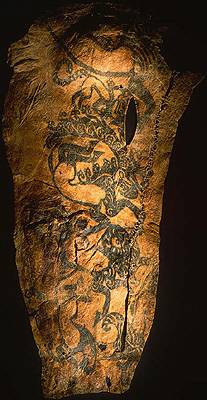Tattooing in prehistoric times

Supposed Neolithic Tattoo,discovered on modern day Romania, Pre
Cucuteni Culture, clay figure 4900-4750BC.

A tattoo on the right arm of a
Scythian chieftain whose mummy was discovered at
Pazyryk,
Russia. The tattoo was made more than 2,500 years ago.
Tattooing has been a
Eurasian practice since
Neolithic times. "
Ötzi the Iceman", dated circa
3300 BC, bore 57 separate tattoos: a cross on the inside of the left knee, six straight lines 15 centimeters long above the kidneys and numerous small parallel lines along the lumbar, legs and the ankles, exhibiting possible therapeutic tattoos (treatment of arthritis). Tarim Basin (West China, Xinjiang) revealed
several tattooed mummies of a Western (Western Asian/European) physical type. Still relatively unknown (the only current publications in Western languages are those of J P. Mallory and V H. Mair,
The Tarim Mummies, London, 2000), some of them could date from the end of the 2nd millennium BC.
One tattooed Mummy (c. 300 BC) was extracted from the
permafrost of Altaï in the second half of the 15th century (the Man of Pazyryk, during the 1940s; one female mummy and one male in Ukok plateau, during the 1990s). Their tattooing involved animal designs carried out in a
curvilinear style. The Man of
Pazyryk, a
Scythian chieftain, is tattooed with an extensive and detailed range of fish, monsters and a series of dots that lined up along the spinal column (lumbar region) and around the right ankle (
illustrated at right).


Walang komento:
Mag-post ng isang Komento